Weekly Current Affairs (15th to 21st October 2024) Part - 2 | General Test Preparation for CUET UG - CUET Commerce PDF Download
GS3/Environment
Guidelines to Combat Greenwashing
Why in news?
- Recently, the Central Consumer Protection Authority (CCPA) released guidelines to regulate greenwashing and misleading environmental claims. This initiative aims to ensure transparency and build consumer trust in eco-friendly marketing practices.
What is Greenwashing?
- Definition: Greenwashing refers to any misleading practice that exaggerates or falsely claims environmental benefits of a product or service.
- Origin: The term was coined in 1986 by environmentalist Jay Westerveld.
- Characteristics: It includes the use of misleading symbols, imagery, or language that promote positive environmental attributes while hiding negative impacts.
- Exclusions: Obvious exaggerations or generic imagery that are not deceptive do not fall under greenwashing.
- Environmental Claims: Representations about a product's or service's components, manufacturing, packaging, usage, or disposal suggesting eco-friendliness.
Examples of Greenwashing:
- Volkswagen Scandal: The company misled consumers by manipulating emissions tests for its supposedly eco-friendly diesel vehicles.
- Other Corporations: Companies like Shell, BP, and Coca Cola have faced similar accusations of greenwashing.
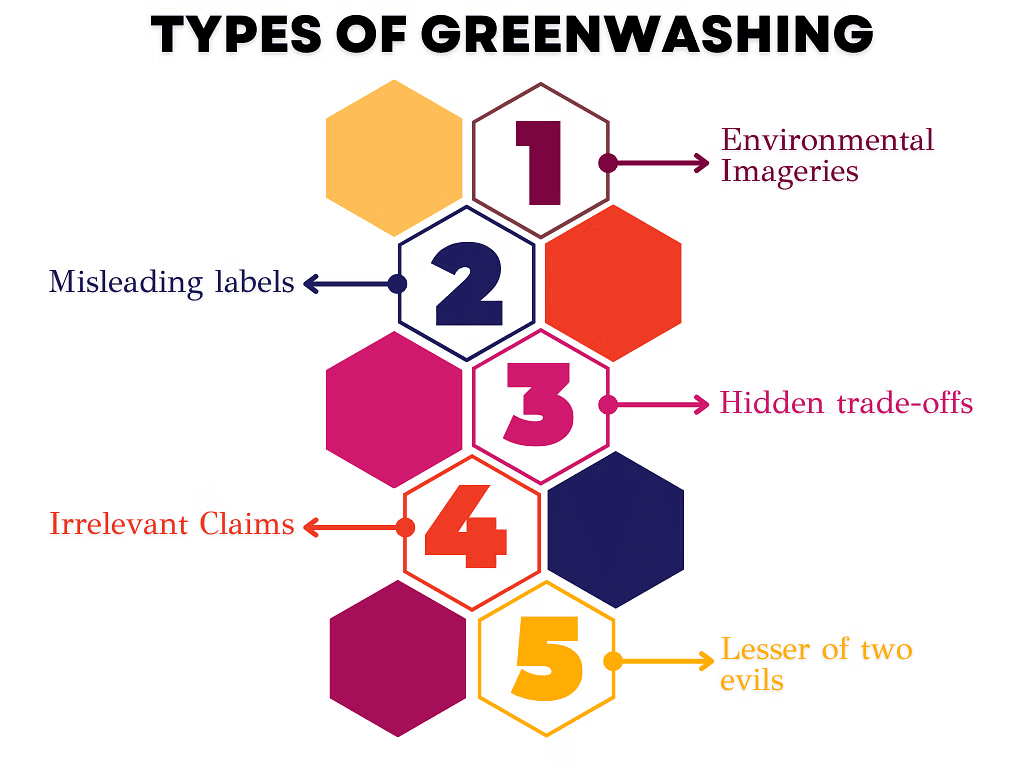
What are the Key Points From the Greenwashing Guidelines?
- Objective: The guidelines aim to combat greenwashing, protecting consumers from deceptive marketing practices by ensuring companies substantiate their environmental claims.
- Applicability: These guidelines apply to manufacturers, service providers, traders, advertising agencies, and endorsers, mandating them to provide credible evidence for their claims.
- Terminology: Terms like eco-friendly, green, sustainable, and natural must be backed by solid evidence, avoiding vague descriptions.
- Verification & Disclosure: Companies must support claims with independent studies or certifications and specify which parts of their products are eco-friendly, accessible via QR codes or URLs.
- Penalties: Companies violating these guidelines may face penalties for misleading advertising and unfair trade practices under consumer protection laws.
- Future Claims: Claims about future environmental goals must be supported by actionable plans.
- Technical Explanations: Companies are required to present technical terms like greenhouse gas emissions in user-friendly language.
- CCPA's Role: The CCPA will oversee enforcement, ensuring compliance, preventing consumer harm, and promoting honest environmental advertising.
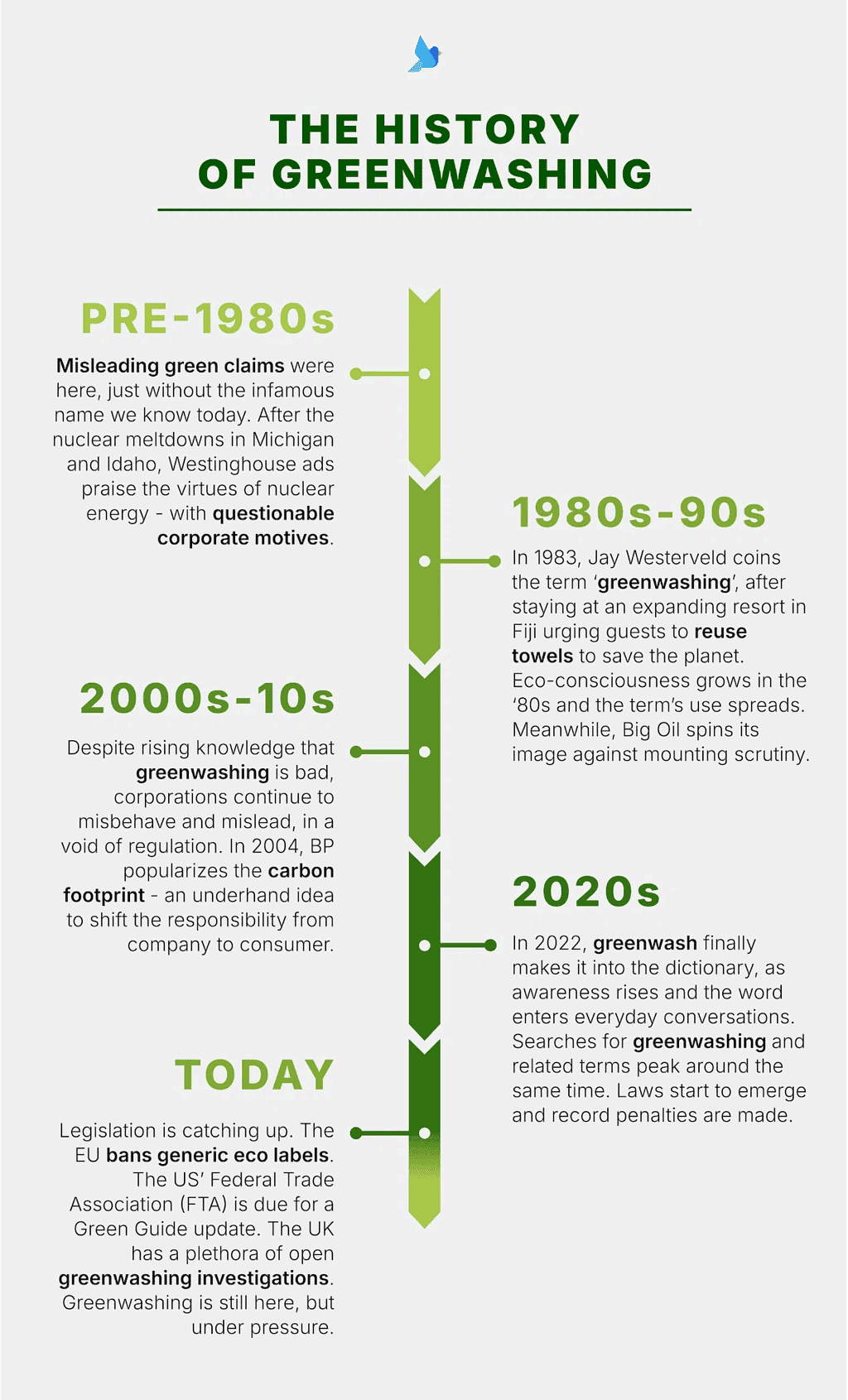
What are the Key Factors Driving Greenwashing in India?
- Growing Environmental Awareness: Increased consumer awareness has led to a demand for eco-friendly products, prompting companies to exaggerate claims.
- Regulatory Pressure: Regulations like the Extended Producer Responsibility (EPR) policy create pressure on companies to appear environmentally responsible.
- Corporate Social Responsibility (CSR): Companies may overstate their environmental efforts to meet CSR spending requirements under the Companies Act, 2013.
- Media and NGO Activism: NGOs expose greenwashing practices, pushing for greater transparency and revealing deceptive claims.
- Consumer Scepticism: Frequent greenwashing has led to distrust in sustainability claims, increasing demand for third-party certifications.
What are the Concerns Surrounding Greenwashing?
- Dilution of Climate Goals: Misleading claims can undermine the credibility of genuine environmental efforts.
- Unfair Recognition: Companies practicing greenwashing may receive undeserved rewards for irresponsible behavior.
- Market Distortion: Greenwashing creates an uneven playing field, disadvantaging firms with real environmental standards.
- Lack of Regulations: Insufficient standards for environmental claims allow greenwashing to persist.
- Carbon Credit Integrity: Greenwashing can weaken the credibility of carbon credit systems in unregulated markets.
Way Forward
- Accountability: Companies must be held responsible for their environmental actions and required to disclose their practices and challenges.
- Support Green Initiatives: Consumers should promote businesses demonstrating proven environmental performance.
- Comprehensive Regulations: Implementing thorough standards for environmental claims will enhance transparency and accountability.
Mains Question
Q. What is greenwashing? Suggest measures to mitigate greenwashing in India.
GS3/Environment
Threat to Mesophotic Coral Ecosystems

Why in News?
- Researchers from the Max Planck Institute for Chemistry have discovered that mesophotic coral ecosystems in the Eastern Tropical Pacific are facing a dual threat: bleaching due to warmer waters above and exposure to colder waters below. The findings, published in the Science of the Total Environment, underscore the rising risks to the health and functionality of these reefs.
What are Mesophotic Coral Ecosystems?
- About: Mesophotic coral ecosystems are located in tropical and subtropical areas at depths ranging from 100 to 490 feet. The main organisms found here include corals, sponges, and algae, which create essential structural habitats.
- Significance: These ecosystems play a critical role in replenishing shallow coral reefs and provide vital habitats for various fish species essential for spawning, breeding, and feeding. Additionally, mesophotic corals contain organisms with specialized defenses that may lead to the development of natural products for medical applications.
- Limited Research: There has been minimal research on these ecosystems due to technological challenges, as they are too deep for traditional scuba diving but too shallow for deep-sea exploration. However, recent advancements in underwater technology have enabled the study of these areas.
What are the Implications for Mesophotic Coral Reefs Under Climate Change?
- Increasing Intensity and Frequency of La Niña Events: Recent studies suggest that major La Niña events, characterized by strong easterly winds, are expected to become more intense and frequent, leading to direct consequences for marine ecosystems.
- Sequential Events: Climate models indicate that extreme La Niña events may increasingly follow significant El Niño events, causing rapid changes in environmental conditions that can adversely affect coral health.
- Cold-Water Exposure: If predictions hold, deep and mid-depth coral reefs in the Eastern Tropical Pacific may experience increased exposure to unusually cold waters right after enduring warm thermal stress from the surface, resulting in compounded stress on coral ecosystems.
- Long-Term Impacts of Cold-Water Bleaching: The observed cold-water bleaching is alarming as it suggests that the effects of such events on deep coral reefs could be long-lasting. The severity of the bleaching and related coral mortality may significantly disrupt the health and functionality of mesophotic coral ecosystems for prolonged periods.
- Broader Context of Coral Bleaching: Concerns are heightened by reports of warm-water bleaching affecting mesophotic reefs in other regions, such as the Red Sea and Indian Ocean, indicating that coral ecosystems worldwide are increasingly susceptible to temperature-related stressors due to climate change.
What are the Implications of Coral Bleaching?
- Loss of Biodiversity: Coral reefs host a diverse array of marine species. Bleaching disrupts these ecosystems, leading to the decline or extinction of species that rely on corals for shelter and sustenance.
- Economic Impact: Coral reefs support fishing, tourism, and coastal protection. Bleaching diminishes fish populations and detracts from the beauty of coral reefs, adversely affecting tourism and fisheries, which are vital economic contributors in many areas.
- Coastal Erosion: Coral reefs serve as natural barriers protecting coastlines from storm surges, erosion, and wave damage. When reefs bleach and die, their structural integrity is compromised, increasing vulnerability to coastal damage.
- Climate Change Feedback Loop: Coral reefs play a role in carbon sequestration. When they die due to bleaching, they cease to absorb carbon dioxide, which contributes to the acceleration of climate change.
- Decline in Natural Medicines: Coral reefs are sources of compounds used in developing medicinal products. The loss of these reefs diminishes opportunities for discovering new medicinal compounds that could benefit human health.
What are the Various Ways to Save Coral from Bleaching?
- Reduce Global Warming: The primary driver of coral bleaching is rising ocean temperatures caused by climate change. Mitigating greenhouse gas emissions through a transition to renewable energy, improving energy efficiency, and promoting sustainable transportation can help slow global warming and protect coral reefs.
- Restore Coral Reefs: Active restoration initiatives, such as coral gardening and transplanting healthy corals to damaged areas, can aid in reviving degraded reefs. These programs also focus on breeding resilient coral species that can better endure rising temperatures.
- Enhance Marine Protected Areas (MPAs): Expanding and effectively managing MPAs can provide coral reefs with a secure environment to flourish. MPAs protect these ecosystems from harmful human activities and support recovery from bleaching events. For example, overfishing and destructive fishing practices threaten coral reefs; sustainable practices can help safeguard these ecosystems.
- Support Scientific Research: Investing in research aimed at understanding coral resilience and developing species that are more tolerant to warmer waters is crucial for coral conservation. Scientists are currently examining heat-resistant corals and strategies to promote their growth.
- Encourage Eco-friendly Tourism: Limiting detrimental tourism activities, such as anchoring boats on reefs, touching corals, or walking on them, can help preserve these delicate ecosystems. Implementing sustainable tourism guidelines can minimize human impact on coral reefs.
Mains Question:
Q. Discuss the causes and implications of coral bleaching, and suggest measures to mitigate its impact and promote coral conservation.
GS2/Governance
Role of Madarsa in Education System

Why in news?
- Recently, the National Commission for Protection of Child Rights (NCPCR) presented its findings to the Supreme Court, stating that the educational curriculum in madrasas lacks necessary comprehensiveness, thus violating the Right to Education (RTE) mandates. The NCPCR highlighted that the textbooks used in these institutions focus predominantly on Islamic doctrine.
What are the Recent Developments Related to Madrasas in UP?
- The Allahabad High Court's judgement in March 2024 deemed the Uttar Pradesh Board of Madarsa Education Act of 2004 unconstitutional, arguing that it violates the secularism principle outlined in the Constitution and infringes on fundamental rights under Article 14, which ensures equality before the law.
- The NCPCR's submission to the Supreme Court followed appeals against the Allahabad High Court's verdict, suggesting all children, regardless of religion, should be transitioned from madrasas to formal schools to ensure basic education in line with the RTE Act of 2009.
What is the State of Madrasas in India?
- As of 2018-19, India had 24,010 madrasas, with 19,132 recognized and 4,878 unrecognized ones.
- Recognized madrasas are affiliated with state boards, while unrecognized ones follow curricula from well-known seminaries like Darul Uloom Nadwatul Ulama and Darul Uloom Deoband.
- Uttar Pradesh leads in the number of madrasas, hosting 11,621 recognized and 2,907 unrecognized institutions, making up 60% of the total madrasas in India.
- Rajasthan comes next with 2,464 recognized madrasas and 29 unrecognized.
- Some states and Union Territories, including Delhi, Assam, Punjab, Tamil Nadu, and Telangana, have no recognized madrasas.
Categories of Madrasas in India:
- Madrasa Darse Nizami: These are public charitable institutions that do not need to follow the state school education curriculum.
- Madrasa Darse Aliya: These madrasas align with state madrasa education boards, with over 20 states in India having established their own boards.
Education and Curriculum:
- Madrasas generally follow a structure similar to mainstream education, with levels such as Maulvi (equivalent to Class 10), Alim (Class 12), Kamil (Bachelor’s degree), and Fazil (Master’s degree).
- The medium of instruction in Madrasa Darse Nizami includes Arabic, Urdu, and Persian, while Madrasa Darse Aliya utilizes textbooks published by state textbook corporations or those prescribed by NCERT.
- Many madrasa boards have adopted the NCERT curriculum, with compulsory subjects like Mathematics, Science, Hindi, English, and Sociology.
- Students may also select an optional subject, such as Sanskrit or Deeniyat (religious studies), which covers the Quran and Islamic teachings, while the Sanskrit option includes Hindu scriptures.
Funding:
- The key funding source for madrasas is the state governments, supplemented by central government assistance under the Scheme for Providing Education to Madrasas/Minorities (SPEMM).
- SPEMM includes two sub-schemes:
- Scheme for Providing Quality Education in Madrasas (SPQEM): Aims to enhance educational standards.
- Infrastructure Development of Minority Institutes (IDMI): Focuses on improving infrastructure.
- In April 2021, SPEMM was transferred from the Ministry of Minority Affairs to the Ministry of Education for better administration.
What is the Role of Madrasas in the Indian Education System?
- Cultural Preservation: Historically, madrasas have played a crucial role in preserving and transmitting Islamic culture, beliefs, and values, fostering a strong sense of identity within Muslim communities in India.
- Education and Literacy: They offer educational opportunities for many Muslim children, especially in regions with limited access to formal schooling. Nonetheless, issues regarding the quality of education persist, with many students unable to progress beyond secondary education, contributing to lower literacy rates in Muslim communities.
- Influence on Ideology: While some madrasas promote positive values, others have been criticized for encouraging extremist ideologies and anti-national sentiments, which can fuel social divisions and communal tensions.
- Legal and Funding Issues: The existence of madrasas raises concerns about secularism and equality in educational funding, with critics arguing that public funds should not support religious education without equally funding other religions to maintain adherence to secular principles.
- Challenges to Integration: Graduates from madrasas often struggle to integrate into the workforce due to a lack of vocational skills and modern education, leading to isolation from mainstream society and limited opportunities for social mobility.
Way Forward
- Vocational Training: Introduce skill development programs within madrasas to equip students with practical skills for job market competitiveness.
- Quality Standards and Accreditation: Establish regulatory frameworks and quality standards for madrasas, including accreditation systems to ensure modern educational practices compliance.
- Equitable Funding: Implement fair funding policies to support all educational institutions, enhancing quality and infrastructure without promoting religious ideologies.
- Community Engagement: Promote awareness and collaboration with parents, community leaders, and NGOs to highlight the importance of holistic education and encourage families to prioritize formal education.
GS3/Environment
Warming of Key Biodiversity Areas (KBAs)
Why in News?
- Recently, a study has revealed that key biodiversity areas (KBAs) located within tropical forests are experiencing a shift towards higher temperature regimes as a consequence of global warming and climate change. The Kunming-Montreal Global Biodiversity Framework aims to protect at least 30% of the world's land by the year 2030, positioning this as a critical objective.
What are Key Highlights of the Study?
- Temperature Changes in KBAs: Approximately 66% of tropical forest KBAs have transitioned to new phases characterized by altered mean annual temperature regimes.
- Regional Temperature Shifts: The percentage of KBAs undergoing temperature changes includes 72% in Africa, 59% in Latin America, and 49% in Asia and Oceania. Notably, in Asia and Oceania, 12% of KBAs have not yet transitioned, with 23% of these remaining unprotected.
- Vertical Temperature Change: The climate beneath the forest canopy remains relatively stable, exhibiting less temperature variation compared to open habitats.
- Disproportionate Impact: Certain KBAs in Latin America (2.9%) and Asia and Oceania (0.4%) have shifted to almost entirely new temperature conditions, with over 80% of measurements falling outside their historical ranges. This includes regions in the tropical Andes Mountains across Ecuador, Colombia, Venezuela, and Panama.
- Stable KBAs: About 34% of tropical forest KBAs have yet to experience new temperature patterns, with over half of these areas under some form of protection. Northern Australia is among the regions least affected by these novel temperature conditions.
What are Key Biodiversity Areas (KBAs)?
- Origin of the Concept: BirdLife International first introduced the concept by identifying Important Bird and Biodiversity Areas (IBA). The success of this model led to the inclusion of additional taxonomic groups, such as plants, butterflies, and aquatic biodiversity. At the World Conservation Congress in Bangkok in 2004, the International Union for Conservation of Nature (IUCN) acknowledged the necessity of a unified framework, which resulted in the 2016 global KBA Standard.
- About KBAs: KBAs are locations crucial for the global persistence of biodiversity. They may host unique species or those found only in specific regions, making them vital for the health of our planet.
- Criteria for Recognition:To qualify as a KBA, a site must meet one of 11 criteria grouped into five categories:
- Threatened biodiversity
- Geographically restricted biodiversity
- Ecological integrity
- Biological processes
- Irreplaceability
- Global KBA Presence: Over 16,000 KBAs have been mapped globally. The Key Biodiversity Areas Partnership, which consists of 13 global conservation organizations, is actively working to identify, map, and conserve KBAs worldwide. In India, there are 862 KBAs, which are essential for biodiversity conservation, such as the Western Ghats.
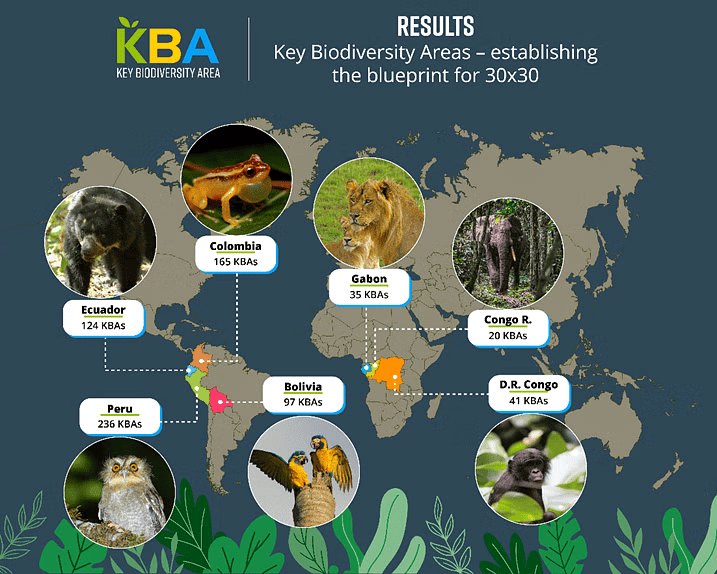
What are the Impacts of Rising Temperatures on Tropical Forests and KBAs?
- Disruption of Stable Microclimates: Rapid changes in temperature can exceed the thermal tolerance of species, leading to stress or mortality. Species inhabiting specific niches within stable microclimates may suffer habitat loss or degradation.
- Threat to Biodiversity: Increased temperatures contribute to habitat degradation, particularly in sensitive ecosystems like rainforests, mangroves, and coral reefs.
- Alteration of Ecosystem Services: Rising temperatures can hinder ecosystem services such as carbon sequestration, water regulation, and nutrient cycling.
- Threat of Invasive Species: Warmer conditions may facilitate the survival and proliferation of invasive species, allowing them to outcompete native species.
- Deforestation and Degradation: Elevated temperatures can exacerbate deforestation and forest degradation, making ecosystems more susceptible to fires, pests, and diseases.
- Shifts in Species Composition: Many species may migrate to higher altitudes or latitudes in search of cooler conditions, potentially resulting in local extinctions.
- Impacts on Human Communities: Rising temperatures threaten forest productivity, endangering the livelihoods of indigenous and local communities that rely on tropical forests for food, medicine, and shelter.
How to Protect Key Biodiversity Areas from Rising Temperatures?
- Develop and Scale Up Nature-based Solutions: Utilize ecosystems to mitigate the effects of climate change while avoiding maladaptive practices such as monoculture plantations. Focus on fostering diverse and resilient ecosystems.
- Restore Ecosystems: Prioritize the protection and restoration of forests, wetlands, peatlands, and mangroves to enhance carbon sequestration and biodiversity.
- Rewilding Initiatives: Investigate rewilding strategies, including the reintroduction of native species, to restore ecosystems.
- Habitat Connectivity Initiatives: Create corridors to connect fragmented habitats, facilitating species migration and adaptation to changing climatic conditions.
- Invasive Species Management: Monitor and inspect goods (plants, animals, soil) at borders to prevent the introduction of invasive species. Introduce natural predators that specifically target invasive species.
Mains Question:
Q. What are Key Biodiversity Areas (KBAs)? How are they impacted by global warming and climate change?
GS2/Polity
SC Upholds Section 6A of Citizenship Act
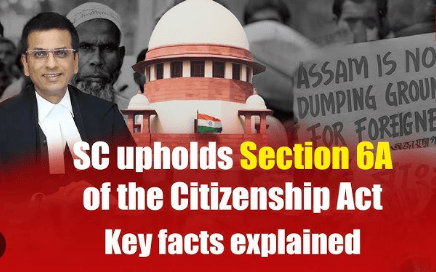
Why in News?
- Recently, the Supreme Court upheld the constitutionality of Section 6A of the Citizenship Act 1955, which allows immigrants from Bangladesh residing in Assam to acquire Indian citizenship. The court emphasized that this legislation aligns with the value of fraternity as stated in the Preamble. It noted that the principle of fraternity should not be applied selectively to some residents of Assam while others are categorized as "illegal immigrants." An NGO petitioned the court, claiming that Section 6A threatens the Assamese people's right to protect their political, linguistic, and cultural identity by allowing illegal immigrants to alter the region's demographics.
What is the Supreme Court’s Ruling?
Majority Opinion:
- Reaffirming Constitutional Validity: The court concluded that Section 6A does not breach Articles 6 and 7 of the Constitution, which set January 26, 1950, as the cutoff date for citizenship for migrants from East and West Pakistan. Section 6A is applicable from a later date, operating independently of the earlier constitutional provisions.
- Justification of Cutoff Date: The court justified the cutoff date of March 25, 1971, citing the Pakistani Army's Operation Searchlight initiated on March 26, 1971, to suppress the Bangladeshi nationalist movement.
- Cultural Protection: The court found that the petitioners did not demonstrate that Section 6A compromised the Assamese people's ability to safeguard their culture. It highlighted that existing constitutional and statutory provisions protect Assam's cultural and linguistic interests.
- Union's Authority: The court affirmed that Parliament enacted Section 6A under its powers from Article 246, Entry 17 of the Union List, which pertains to citizenship, naturalization, and aliens. Assam's special citizenship law does not violate Article 14 (Equality) since the state’s migrant situation is unique compared to the rest of India.
- Acknowledgment of Migration Issues: The court acknowledged the ongoing migration from Bangladesh as a significant burden on Assam. It stated that a nation can accommodate immigrants while pursuing sustainable development and equitable resource distribution.
- Responsibility Clarification: It was emphasized that Section 6A should not bear sole blame for the situation; the government's failure to timely detect and deport post-1971 immigrants from Bangladesh contributed significantly.
- System Critique: The court criticized the current mechanisms and tribunals responsible for identifying illegal immigrants in Assam, describing them as inadequate for timely enforcement of Section 6A and related laws, such as the Immigrants (Expulsion from Assam) Act, 1950, and the Foreigners Act, 1946.
- Need for Oversight: The court stressed that immigration and citizenship law enforcement requires judicial supervision and should not be left to the discretion of authorities. It called upon the Chief Justice of India to establish a Bench for monitoring the implementation of these laws in Assam.
Dissenting Opinion:
- Unconstitutionality of Section 6A: The dissenting opinion declared Section 6A unconstitutional with prospective effects, arguing that concerns regarding different ethnic groups infringing on cultural and linguistic rights are unfounded.
- Balancing Development and Immigration: The dissent posited that sustainable development and population growth can coexist without conflict. It warned that accepting the petitioners' claims could lead to restrictions on domestic inter-State movement due to immigration impacts on local rights to sustainable development.
What is Section 6A of the Citizenship Act 1955?
About Section 6A:
- Section 6A was introduced as part of the Citizenship (Amendment) Act, 1985, following the Assam Accord of 1985.
- This section grants Indian citizenship to immigrants who entered Assam from Bangladesh before January 1, 1966.
- Those who arrived between January 1, 1966, and March 25, 1971, can be granted citizenship after fulfilling specific procedures and conditions.
- However, it denies citizenship to immigrants who entered Assam after March 25, 1971.
The Assam Accord:
- The Assam Accord is a tripartite agreement involving the Central Government, the State Government of Assam, and leaders of the Assam Movement, aiming to halt the influx of illegal migrants from Bangladesh.
- It introduced Section 6A into the Citizenship Act of 1955, specifically addressing the large-scale migration before the 1971 Bangladesh Liberation War.
- The Accord mandates the detection and deportation of foreigners who entered Assam after March 25, 1971, coinciding with the creation of Bangladesh.
- The introduction of Section 6A reflects the unique historical and demographic challenges faced by Assam during this period.
What can be the Implications of this Judgement?
Immigrant Recognition:
- The ruling upholding Section 6A ensures continued legal protection and citizenship rights for immigrants from Bangladesh who entered Assam before March 25, 1971.
- This reinforces India's commitment to protecting individuals displaced by conflict.
Assamese Identity Preservation:
- The majority opinion dismisses the idea that immigrants' presence inherently infringes upon the cultural and linguistic rights of the Assamese people.
- Despite demographic changes, the rights of the Assamese community are safeguarded through existing constitutional protections, such as Article 29(1), which allows them to maintain their identity.
Tensions on Demographic Shift:
- Critics argue that ongoing immigration disrupts Assam’s demographic balance, potentially threatening its cultural identity and economic resources.
- This situation could lead to local demands for stricter immigration controls or inspire political movements focused on cultural preservation.
Resource Allocation:
- Immigrants gaining citizenship will also benefit from resources and rights associated with it, potentially exacerbating strain on Assam's limited economic resources.
- This may necessitate more comprehensive policies to ensure fair resource distribution and mitigate economic inequalities.
Pressure on Immigration Laws:
- The judgment highlights the need for more effective enforcement of immigration laws, particularly regarding the identification and deportation of illegal immigrants who arrived after the 1971 cutoff.
Bangladesh Relations:
- By not recognizing post-1971 immigrants as Indian citizens, the ruling could exacerbate tensions with Bangladesh, as it may be perceived as India shifting responsibility for these immigrants to its neighbor.
- This situation could complicate regional cooperation on border management, migration control, and security, thus impacting India-Bangladesh relations.
Mains Question:
Q. Discuss the implications of the Supreme Court's recent judgement on Section 6A of the Citizenship Act for Assam. How does the judgement balance humanitarian concerns with local development challenges?
GS3/Science and Technology
Poor Performance of India in Science Nobel Prizes
Why in news?
- It has been 94 years since an Indian scientist has won a Nobel Prize in the sciences — Physics, Chemistry, or Medicine — while conducting research in India. The limited success of Indian scientists in attaining Nobel Prizes is often perceived as a reflection of the state of scientific research in the country, although various other factors also play a role. The last Indian to win a Nobel Prize in science was C.V. Raman for his work on the scattering of light in Physics in 1930.
Reasons for Poor Performance of India in Science Nobel Prizes
- Low Public Funding for Research: The funding provided by the Indian government for scientific research is inadequate, which restricts the potential for groundbreaking discoveries. Currently, direct funding for basic research has stagnated at 0.6-0.8% of GDP, significantly lower than other BRICS nations. Furthermore, India's overall expenditure on R&D has declined from 0.82% to 0.64% of GDP between 2005 and 2023.
- Excessive Bureaucracy: Bureaucratic obstacles within Indian research institutions hinder innovation and delay scientific advancements. For example, procuring equipment at IIT Delhi can take up to 11 months, and a recent Rs 150 crore GST notice imposed on IIT Delhi exemplifies how tax policies can impose financial burdens on academic institutions.
- Small Researcher Pool: India has a disproportionately small number of researchers relative to its population, with the number of researchers being five times lower than the global average, limiting the pool of potential Nobel contenders.
- Dependence on Individual Brilliance: The lack of a robust research ecosystem means that India's chances of winning future Nobel Prizes heavily rely on the individual brilliance of its scientists rather than systematic support or infrastructure.
- Discretion in Research Institutions: The heads of research institutions often prioritize personal career advancement over breakthrough research, seeking prestigious awards such as the Padma Shri or Bharat Ratna instead of fostering innovation.
- Lack of Clear Research Direction: Many scientists tend to pursue outdated or irrelevant topics, often based on failed experiments from the USA or EU, which do not have practical applications in India. For instance, there is a neglect of water technology and agricultural innovation in favor of high-energy particle accelerators or complex nuclear fusion projects.
- Focus on Quantity Over Quality: A significant portion of research conducted in government-funded institutions is aimed at generating numerous publications rather than producing substantial innovations.
- Dependence on Foreign Technologies: Indian scientists frequently replicate or adapt technologies developed abroad instead of creating original solutions, which does not necessitate deep scientific innovation or merit.
- Over Reliance on Private Sector Success: The notable achievements in vaccine development during the Covid-19 pandemic were mainly accomplished by private sector labs, highlighting a disconnect between government-funded research institutions and significant scientific breakthroughs, which undermines the credibility of government labs.
- Legacy of Mediocrity: Even when scientists trained abroad return to India, they often fail to reach their potential due to an unhealthy institutional environment, becoming entrenched in a cycle of publishing irrelevant research and seeking promotions rather than pursuing excellence.
- Historical Missed Opportunities: Several significant Indian scientists have made groundbreaking contributions but were overlooked or not nominated for Nobel Prizes. For example, Jagadish Chandra Bose demonstrated wireless communication in 1895 but was not nominated, while the prize went to Guglielmo Marconi and Ferdinand Braun in 1909. Similarly, K.S. Krishnan co-discovered the Raman scattering effect with C.V. Raman but did not receive a nomination.
- Nominations but No Wins: Numerous Indian scientists, including Meghnad Saha, Homi Bhabha, Satyendra Nath Bose, G.N. Ramachandran, and T. Seshadri, have been nominated several times for Nobel Prizes but have never won.
- Western Dominance in Nobel Prizes: The Nobel Prizes are predominantly awarded to scientists from the US and Europe, where there is a stronger scientific infrastructure and research ecosystem. Of the 653 Nobel Laureates in Physics, Chemistry, or Medicine, over 150 are from the Jewish community, yet Israel itself has only four Nobel Prize winners in science.
What can be Done to Improve the Performance of India in Science Nobel Prizes?
- Increase Public Funding for R&D: The Indian government should aim to increase the GDP percentage allocated to research and development, targeting at least 1.5% in the near future.
- Encouraging High-Impact Research: There should be a push for high-risk, high-reward research initiatives that could lead to revolutionary technologies.
- Revamping Evaluation Processes: Establishing diverse panels of reviewers with relevant expertise for evaluating research proposals can help ensure that valuable ideas are not missed due to biases or misconceptions.
- Expand the Researcher Pool: Promoting STEM education and investing in higher education will help cultivate a larger and more skilled group of researchers.
- Reform Research Institutions: Funding and opportunities should be allocated based on merit and potential societal impact rather than personal ambitions.
- Leverage Public-Private Partnerships: Encouraging collaborations between government research institutions and private firms can enhance research capabilities and drive innovation.
- Recognise Scientific Talent: Establishing national awards and recognition programs for significant scientific contributions can motivate more ambitious efforts towards groundbreaking work.
- Strengthen Global Collaborations: Indian scientists should be encouraged to collaborate with international research communities to share knowledge and resources, thereby enhancing the profile of Indian research globally.
Mains Question:
Q. Discuss the reasons for the limited success of Indian scientists in winning Nobel Prizes in the fields of Physics, Chemistry, and Medicine.
GS3/Economy
MSP and its Legalisation
Why in news?
- Recently, the Cabinet Committee on Economic Affairs (CCEA) raised the Minimum Support Price (MSP) for six rabi crops including wheat, barley, gram, lentil, rapeseed, mustard, and safflower. This increase has sparked discussions regarding the farmers' requests for MSP legalization and its implications on the agricultural framework.
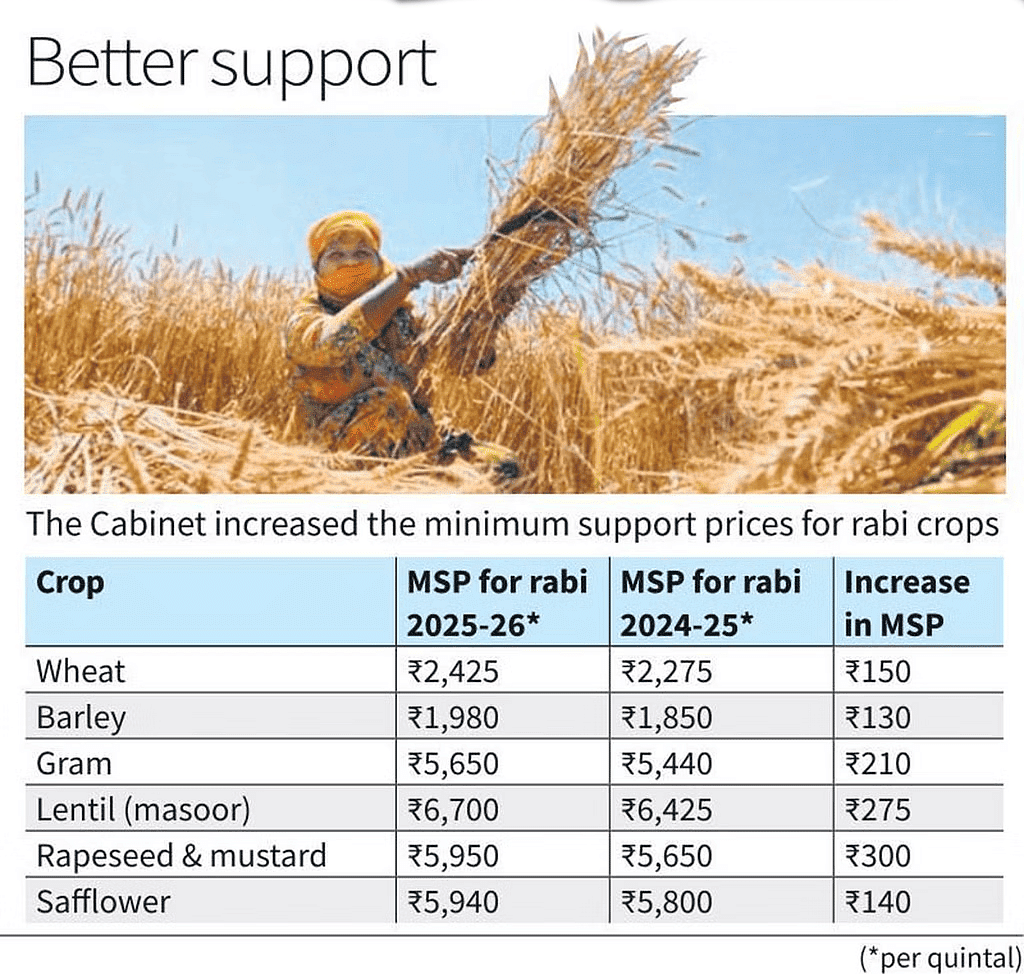
What is the Minimum Support Price?
- The MSP system was initiated in 1965, establishing the Agricultural Prices Commission (later renamed as CACP) to intervene in the market, enhance national food security, and safeguard farmers from drastic market price drops.
- The CACP calculates three types of production costs for each crop, both at state and national levels.
- A2: This includes all out-of-pocket costs incurred by farmers, such as expenses on seeds, fertilizers, pesticides, hired labor, leased land, fuel, and irrigation.
- A2+FL: This encompasses A2 costs along with an estimated value of unpaid family labor.
- C2: This is a more comprehensive cost that adds rent and interest for owned land and fixed capital assets to A2+FL.
- The government claims that the MSP is set at a minimum of 1.5 times the all-India weighted average Cost of Production (CoP), calculated as 1.5 times the A2+FL cost.
What are the Concerns Related to MSP in India?
- Limited Coverage: Only 6% of farmers benefit from MSP, mainly those in regions like Punjab and Haryana, while farmers in other states remain largely excluded.
- Skewed Crop Focus: The MSP primarily supports a limited number of crops, particularly rice and wheat, which discourages diversification and can lead to overproduction of these staples.
- Overburdening Procurement System: The MSP leads to significant government procurement, especially of rice and wheat, causing storage issues and wastage, thereby straining the resources of the Food Corporation of India (FCI).
- Environmental Impact: The emphasis on water-intensive crops like rice raises environmental concerns, particularly groundwater depletion in regions such as Punjab.
- Dependence on Middlemen: Farmers often face challenges accessing procurement agencies, which increases reliance on middlemen who may exploit them by offering lower prices.
What are the Needs and Challenges for Legalising MSP in India?Need:
- Income Security for Farmers: Legalising MSP would guarantee farmers a stable income, shielding them from market price fluctuations, which is essential during periods of price crashes, especially after bumper harvests.
- Boost to Agricultural Investment: A legally guaranteed MSP could motivate farmers to invest in agricultural inputs, modern technologies, and sustainable practices, leading to enhanced productivity.
- Reduction of Rural Poverty: A stable MSP can alleviate rural poverty, improving the living conditions for small and marginal farmers.
- Stabilizing Agricultural Markets: MSP acts as a tool to stabilize prices, mitigating the volatility of crop prices in open markets and easing inflation pressures on consumers.
- Mitigation of Distress Sales: Legal enforcement of MSP could help prevent farmers from having to sell at distress prices due to lack of remunerative prices.
Challenges:
- Fiscal Burden on the Government: Legalising MSP for all crops would impose a significant financial burden on the government due to the need for large-scale procurement at guaranteed prices, estimated to exceed Rs 10 lakh crore annually.
- Market Distortion: Legal MSP could disrupt market dynamics, discouraging private sector participation and potentially leading to competitiveness issues in both domestic and export markets.
- Storage and Infrastructure Constraints: Implementing MSP would necessitate extensive enhancements in storage and logistics infrastructure, which is currently inadequate.
- Implementation Challenges: Uniform MSP enforcement across diverse agricultural practices and climatic conditions poses significant challenges, as production costs vary by state.
- Overproduction and Environmental Impact: Legalising MSP may encourage overproduction of crops like wheat and rice, exacerbating environmental issues such as soil degradation and groundwater depletion.
Way Forward
- Correcting MSP Implementation: Reform the MSP framework to align with regional needs and market demands, enhancing procurement infrastructure and promoting crop diversification.
- Encourage Crop Diversification: The government should incentivize the growth of diverse crops such as pulses, oilseeds, and millets to promote sustainable farming practices and lessen pressure on water resources.
- Direct Benefit Transfers (DBT): To minimize inefficiencies and reduce dependence on middlemen, the government could implement DBT, allowing farmers to receive the difference between MSP and market price directly.
- Allied Activities for Farmers: Promote alternative agricultural activities like horticulture, dairy farming, and fisheries to provide supplementary income sources, enhancing overall sustainability.
- Skill Development for Manufacturing Jobs: Expand skill development initiatives to equip rural populations, especially youth and women, with skills for non-agricultural employment, facilitating a transition to diverse income sources.
Mains Question:
Q. Critically analyse the concerns associated with the legalisation of Minimum Support Price system and suggest a way forward.
|
164 videos|626 docs|1128 tests
|
FAQs on Weekly Current Affairs (15th to 21st October 2024) Part - 2 - General Test Preparation for CUET UG - CUET Commerce
| 1. What are the key strategies to combat greenwashing in businesses? |  |
| 2. Why are mesophotic coral ecosystems considered important for biodiversity? |  |
| 3. How does the role of Madarsa in the education system impact community development? |  |
| 4. What is the significance of warming in Key Biodiversity Areas (KBAs)? |  |
| 5. What are the implications of the Supreme Court upholding Section 6A of the Citizenship Act? |  |





















